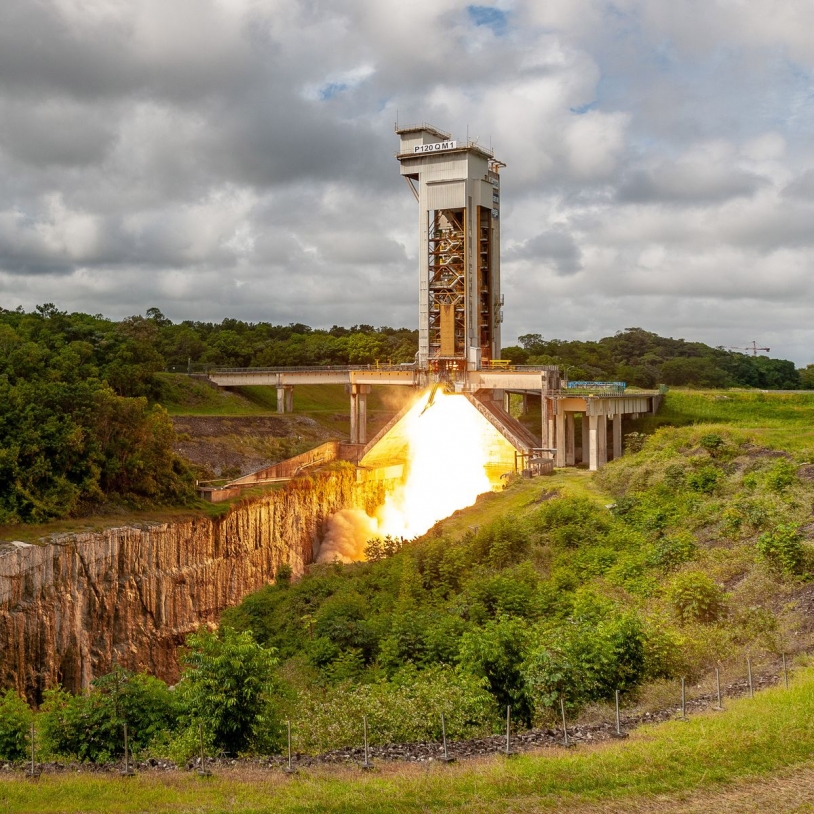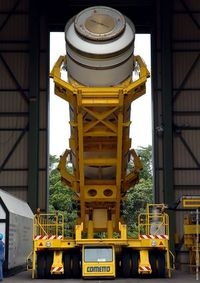Production plants

Production of Ariane and Vega boosters
Some components of the Ariane and Vega/Vega-C launchers are manufactured at the GSC: they include the boosters, which are essential for the launcher’s thrust at lift-off. Ariane 5 has two boosters, called EAPs (solid rocket boosters), which are mounted on either side of the launcher. Vega has only one, its first stage, called P80. The new Vega-C launcher has a booster called P120C, which will also equiped Ariane 6, and wich is also produced at the GSC.
To produce the boosters required for the ten or so Ariane 5 and Vega/Vega-C launches per year, the Guiana Space Centre has set up a fully-fledged industrial booster production centre. Set up on 300 hectares, this “booster zone” includes three sites involved in the preparation, assembly and testing of solid rocket boosters.
Producing the propellant
In the Usine de Propergol de Guyane (Guiana Propellant Plant), mixers mix the propellant paste consisting of fuel (aluminium powder), oxidiser (ammonium perchlorate), and a binder (polybutadiene resin). Once the paste is made, it is poured into the empty casing of a booster segment corresponding to the Ariane or Vega launcher. The paste is then baked at 50 °C for 10 days, deep inside a casting pit. When the paste has solidified, each segment undergoes a series of checks. It is then transferred to the booster integration building on a dedicated 200-tonne trailer with 56 wheels.
Each booster consists of three segments, two of which are manufactured in French Guiana and the third in Italy. Operated by Regulus, the Guiana propellant plant has a maximum capacity of 32 to 40 segments per year. In view of the hazardous materials handled in the plant, the plant is classified as a Seveso 3 top tier site.
Assembling and equipping the booster
Loaded at the Guiana propellant factory, the three segments are assembled and equipped in the booster integration building (BIP) to make a stage for an Ariane or Vega launcher. In this 47-metre high building, there are nine levels of walkways for operators to access the entire booster. They equip the booster with various components: nozzle and igniter, cables, sensors, fastening devices, separation rockets, and skirt. After all these operations, the booster will become a solid rocket booster ready to equip an Ariane or Vega launcher.
The boosters are assembled in the launcher integration building by Europropulsion.
Storing the boosters
In the EAP storage building, the boosters are stored as and when they are manufactured until they are used in the final assembly building for Ariane 5 and in the launch zone for Vega. The maximum storage capacity is four boosters, which makes it possible to keep ahead of production.

The baptism of fire
Before being mass-produced, the solid rocket motors are tested on the solid booster test bench (BEAP). Designed and operated by CNES since 1993, this test bench is a small launch zone to verify the proper functioning of a booster. The BEAP consists of a 50-metre high tower and an enormous flue used to release the gas jet. Placed horizontally, in conditions strictly identical to a real launch, the booster is ignited and its operation is closely monitored through a hundred or so real-time measurements. Between 1995 and 2018, 17 tests were conducted on the BEAP.
Production of gases and fluids
Five plants spread over more than 6 hectares, connected by more than 60 kilometres of pipelines: this is the Air Liquide Spatial Guyane site at the GSC!
Three gases needed for the operations are produced directly at the heart of the GSC: nitrogen, helium and compressed air.
“LOX” and “LH2”: essential fluids for launches!
The acronyms LOX and LH2 stand for Liquid Oxygen and Liquid Hydrogen, two fluids which are essential for launches. Ariane 5 primarily uses LOX and LH2 to lift off: more than 140 tonnes of liquid oxygen, the launcher’s oxidiser, and about 28 tonnes of liquid hydrogen, the fuel.
The LOX plant produces liquid oxygen from ambient air. As both fluids can only be kept in a liquid state at extremely low temperatures, they are produced according to the needs of the launch base.

Increased production needs since Ariane 4
Set up in French Guiana in 1969, Air Liquide joined the GSC in 1986 in order to maintain the cryogenic facilities of the Ariane 4 launch complex. Two years later, the company began operating a new liquid oxygen and nitrogen plant directly on the same launch complex.
On 1 January 1991, in response to a considerable increase in space market activities in French Guiana, the subsidiary Air Liquide Spatial Guyane (ALSG) was founded and set up a helium gas production and distribution facility, as well as a liquid hydrogen production plant.
Today, ALSG is fully committed to energy transition by implementing a major programme to modernise its facilities.

1,400,000litres
This is the amount of liquid hydrogen required for one Ariane 5 ECA launch (including any carry-overs). This volume represents one and a half months of production for the LH2 plant.
Virtual tour of the Liquid Hydrogen Plant: http://static.zooomez.fr/medias/csg/usinelh2/
Virtual tour of the Liquid Oxygen Plant: http://static.zooomez.fr/medias/csg/usinox/



